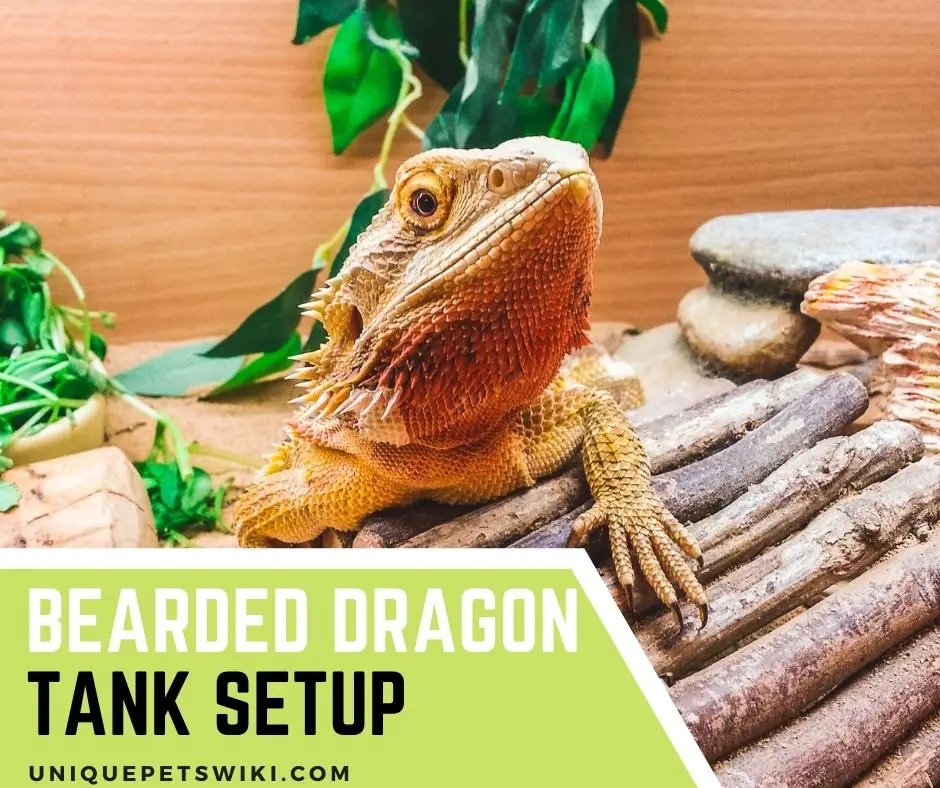Any bearded dragon guru will tell you it’s easy to keep one as they are hardy and easy to care for.
However, any exotic pet requires a similar habitat as its origin to thrive in captivity.
As such, it is critical to understand your bearded dragon habitat requirements for it to thrive.
For this purpose, we came up with this article to help all bearded dragon beginners set up a suitable habitat and help their pets live longer and comfortably.
Remember, you can do what you know now, but better if you know better. Keep reading!
Contents
Bearded Dragon Tank Setup: The Most Detailed Instructions
Bearded dragons originate from Australia, where the climate is hot and dry. It is critical to mimic bearded dragons’ natural habitation by using a good substrate, UVB light and heating, humidity, and landscaping to make a perfect home for them.
Additionally, a large tank is essential to help your bearded dragon move freely and eliminate any possible stress.
This article will discuss all these factors and tell you how to use them correctly and keep your bearded dragon happy in captivity.
Identify Location for Bearded Dragon in Your Home
Before bringing in a bearded dragon to your home, you must arrange its house and make it suitable for your pet.
The first step would be identifying a suitable place to locate your beardie’s cage. Most beginners will assume placing the terrarium where they can get direct sunlight would be the best.
However, it is not the case. Even though bearded dragons live in hot and dry areas, direct sunlight in a glass terrarium can dangerously increase the ambient temperature.
As a result, your bearded dragon becomes extremely hot with no possible way to cool itself down and eventually dies.
Bearded dragons are cold-blooded animals and depend on the ambient temperature to warm or cool off their bodies.
Therefore, it would be best if you placed your bearded dragon’s cage in a quiet room with a well-controlled climate.
Additionally, get a stable base to place on the terrarium and ensure you can easily access it.
And, if you have small babies or other pets, make sure that your bearded dragon’s cage is NOT within their reach.
Enclosure for Bearded Dragon
A bearded dragon’s enclosure is vital for their good health, happiness, and comfort.
They depend on direct sunlight to warm their bodies and shades and caves to cool off their body in the wild. They can also roam around in the forest to hunt and exercise.
In captivity, they depend on their owners to provide a similar habitation to keep them healthy.
As such, it is critical to invest in a good enclosure to keep your bearded dragon healthy and happy.
When buying an enclosure for your bearded dragon, size and material are the major factors that determine a good terrarium.
Enclosure size and Material By Age
A good size will help your bearded dragon move freely, while the material will determine the longevity and the ability to maintain a good temperature and humidity.
The size of an enclosure for bearded dragons depends on their age. For instance, a bearded baby dragon will be comfortable in a 20-gallon while adults require a 50-120-gallon tank.
The best way to determine the best size for your bearded dragon is by first knowing its size.
A good tank should be twice larger than your bearded dragon. For instance, if your beardie is 10” long, let the terrarium be 20-gallon or bigger.
Remember, if you are getting a bearded baby dragon, it will grow very fast. Therefore, you should consider getting a larger tank.
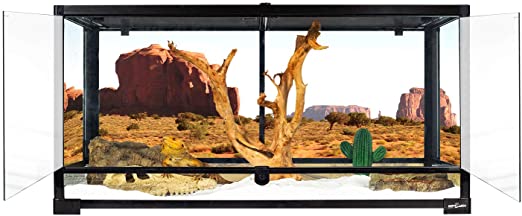
Best and Worst Material
It can be overwhelming to choose the best material for your bearded dragon’s terrarium in a market filled with plenty.
It may be the hardest task for a beginner, especially because you don’t want to make any mistakes.
Therefore, in this section, we discuss the most common materials for bearded dragon terrarium.
Glass
Glass enclosures are the most popular in the market. They come in different designs, such as top or front-opening doors.
The front opening doors are the best in terms of accessibility. They make it easy for you to handle your bearded dragon and also easy to clean.
They are also sturdy and come with a screen lid that helps in airflow. However, glass is a bad heat insulator.
Therefore, it can get extremely cold, and thus, you need to check the tank’s temperature using a thermometer regularly.
The average cost of a glass terrarium 48”x24”x24” is $400.
Wood and Glass
Wood is a good conductor of heat. Therefore, if you get a wooden tank with a glass front, you can be sure the ambient temperature will be perfect for your bearded dragon.
Also, the front glass will make the inside of the terrarium visible making it easy for you to observe your bearded dragon’s activities.
On this note, wood and glass enclosures make the perfect homes for bearded dragons.
The average cost of a wooden glass terrarium 48”x24”x24” is $400.
PVC Plastic
Plastic enclosures are also common and good for bearded dragons. They are lightweight and come in various colors.
PVC plastic terrariums are good for people planning to keep more than one bearded dragon.
However, they have poor airflow making them bad in keeping the required humidity.
But, if you can regularly check the ambient humidity, then PVC plastic enclosures would be perfect.
The average cost of a PVC 48”x24”x24” enclosure is $500-600.
Instruct Owners To Set Up An Enclosure
Once you get an enclosure, the next step would be to set it up. Like we said earlier, you need to keep the tank away from the direct sunlight, loud noise, predators, and small children.
Also, you should ensure to place the tank in a sturdy base to prevent an accident. A stabling base can cause stress to your bearded dragon.
Bearded dragons are diurnal. Thus, they are active during the day and sleep at night. It is critical to keep them in an environment that does not discourage their usual behavior.
Therefore, you should ensure that the room you place your bearded dragon’s tank can light up during the day and get dark at night.
Substrate For Bearded Dragon
Imagine sleeping in a bare bed with no beddings or mattresses. It can be stressful, right? Even bearded dragons get stressed in an empty tank.
Bearded dragons require their home to feel comfortable and similar to their natural environment.
As such, it is impossible to forgo substrate. Lack of substrate will cause tremendous stress to your bearded dragon, rendering them susceptible to other illnesses.
Lack of substrate will also make it almost impossible to maintain the required humidity.
Imagine how the forest looks. It is imperative to make your bearded dragon’s home feel as comfortable as the forest.
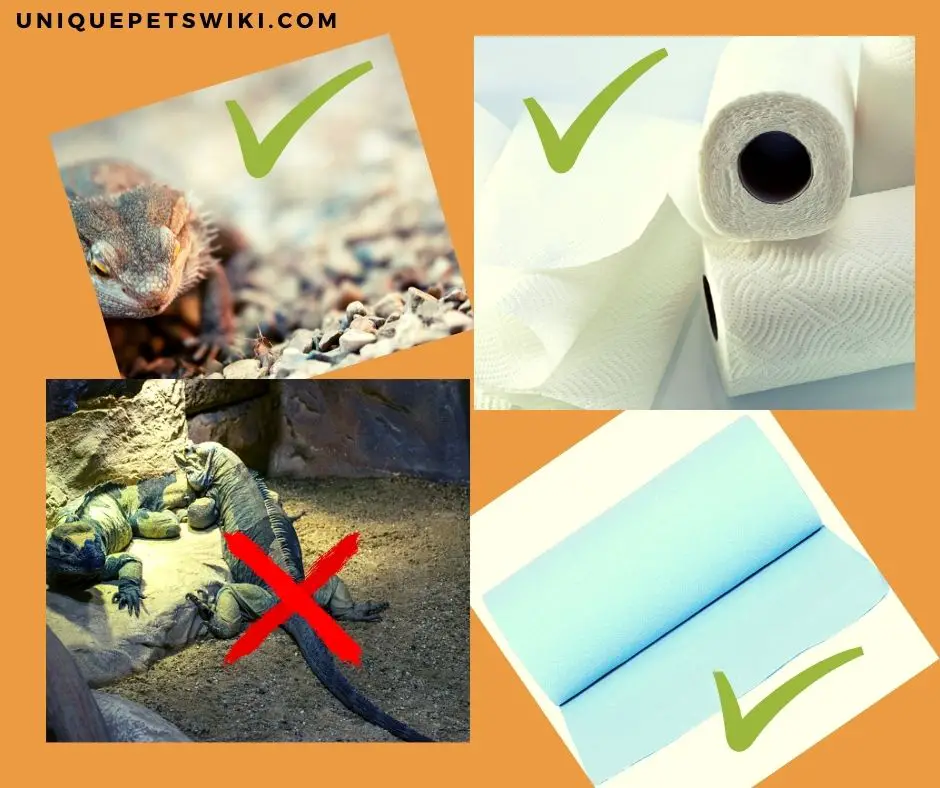
Best Substrate For Bearded Dragon
The kind of substrate you use should be safe, plenty, and easy to clean. A good substrate should make your bearded dragon feel comfortable and pose little or no risks.
There are various substrates you can choose from in the market, and they all vary from price to suitability. Here is a list of the best, depending on your budget and suitability.
Reptile Carpet
Reptile carpet is the best. It comes in different colors and designs, and the most common colors are green, brown, or tan. To give it a natural look, it can have a grass and rocks texture.
It is also easy to install and does not keep excessive heat or humidity. However, it is expensive and not easy to clean.
Additionally, it takes time to dry, and thus you may need at least two carpets to alternate between cleaning.
The average cost for a reptile carpet is $10-30. Shop here
Last update on 2022-12-30 / Affiliate links / Images from Amazon Product Advertising API
Newspaper or Paper Towels
If you are budget-oriented, then newspaper or paper towels could be the best substrate for your bearded dragon.
However, it is worth noting that newspapers can shred during your bearded dragon’s exploration, especially adults. Therefore, it would be best if you used newspaper substrate only on juveniles.
Another major disadvantage of the newspaper is they are not reusable and can easily get a dump.
And, if you want your bearded dragon to experience a naturalistic feel, newspaper and paper towels are not ideal.
The annual average cost of newspaper and paper towels are $10.
Tiles
Tiles are one-time installments and, thus, inexpensive. To make them less slippery, you can sand glue them permanently. Tiles do not pose impaction risks, and they are easy to clean.
However, you have to ensure to choose heat observant tiles to prevent the floor from being cold.
Additionally, if you are using tiles as the substrate, you should include plenty of climbing accessories to prevent your bearded dragon from staying excessively on those tiles.
Even though tiles are one-time installation, it cannot be easy to install them as you will need to have the exact measurement to fit in the tank.
Tile installation in your bearded dragon cage is approximately $5-20.
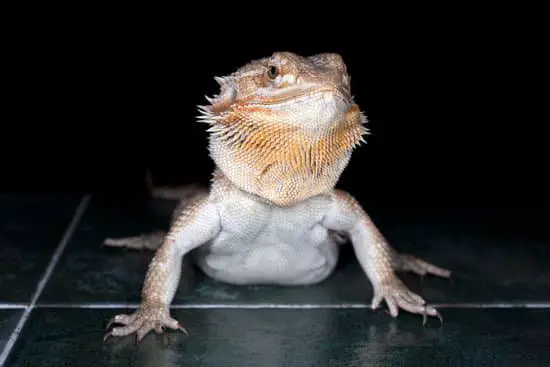
Rubber Shelf Liner
Rubber shelf liners are inexpensive and readily available in hardware and home goods stores.
One roll can serve you several times, and they are much more durable than paper towels.
However, they are bad conductors of heat and excellent insulators. Thus, they take longer to heat and to cool off.
Additionally, they absorb waste easily, and thus you should clean them every two weeks.
The average annual cost is $10.
Alfalfa Pellets
If you prefer using a loose substrate, Alfalfa pellets are the best. It is easy to replace alfalfa, and you can also buy in bulk, and Alfalfa pellets feel more natural for bearded dragons.
However, bearded dragons can ingest alfalfa pellets and suffer from impaction, especially the juveniles.
Also, filling a 120-gallon or larger with alfalfa pellets can be quite expensive.
The average annual cost for alfalfa pellets is $120.
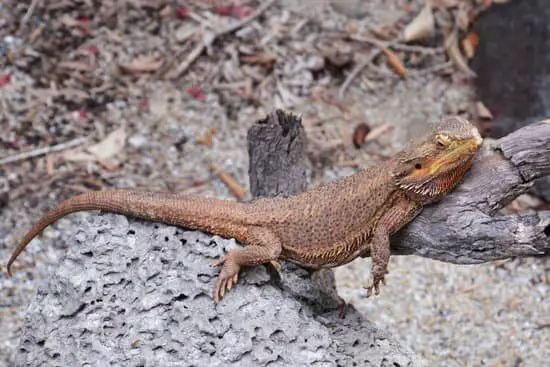
Worst Substrate For Bearded Dragon
The wrong choice of substrate can cause impaction and other health issues for your bearded dragon.
All loose substrates such as sand, wood chips, and millet substrate can provide a natural feel for your bearded dragon. However, if ingested, they are not digestible and thus pose a high risk of impaction.
On this note, it would be best if you don’t use non-loose substrates such as reptile carpet, tile, shelf liner, newspaper, or paper towel to keep your bearded dragon safe.
UVB Light and Heat
Imagine how the climate in the Australian desserts feels. It’s extremely hot during the day and cold at night. Bearded dragons adapt well in similar conditions.
But, if your bearded dragon cage is inside a room, the temperature and lighting cannot match the bearded dragon’s natural habitat.
Therefore, you must install lighting and heating accessories to mimic the bearded dragon’s natural habitat.
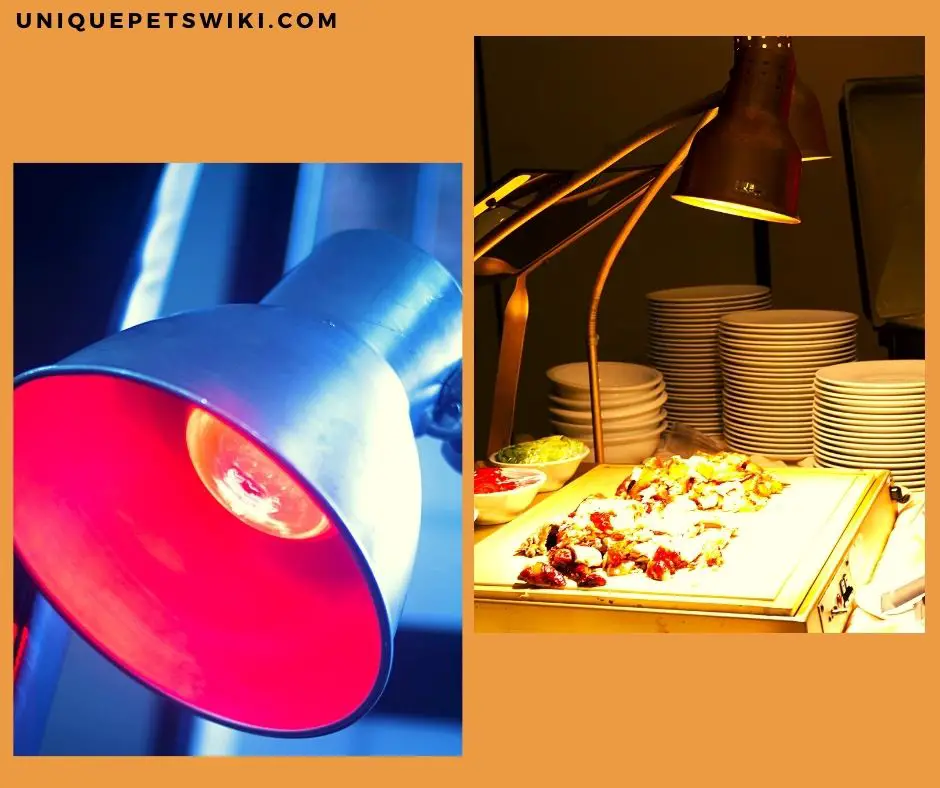
Ideal UVB Light and Heat for Bearded Dragon
When we talk about bearded dragons being diurnal animals, they are active during the day and sleep at night. In the wild, the sun is their natural lighting, and they know it’s the night when it’s dark.
In captivity, you need to install a lighting bulb to represent the sun and switch it off at night to encourage their usual behavior.
And, since the ambient temperature in your home could be different from their natural habitat, it is critical to add heating accessories.
To meet the ideal UVB light and heat, you will need a heat lamp, UVB bulb, and a heat emitter. All those three work together to match a bearded dragon’s natural habitat.
The bearded dragons require 12-14 hours of lighting to maintain their natural sleep cycle.
Also, during the day, they bask in the sun to warm their bodies after a cold night. Therefore, it is necessary to install a basking bulb to provide UVB lighting for your bearded dragons.
The ideal temperature for the basking spot should be 90-950F for adults and 95-1000F for juveniles.
Since you need to switch off the heat and light lamp at night, you need to use another type of heating to warm your bearded dragon’s cage if the temperature is below 650F.
Ceramic heaters come in handy as they will warm up your bearded dragon’s cage without providing light.
How To Set Up the UVB light and light
UVB lighting is very critical for bearded dragons and all reptiles at large. It provides them with Vitamin D3 that helps them absorb calcium and use it.
Lack of UVB will cause your bearded dragon to suffer from metabolic disease as well as tremendous stress.
When setting up UVB light for your bearded dragon, the first step is getting the correct size for their tank.
The ideal size for a UVB light should cover at least 2/3 to ¾ of the cage, and this helps the bearded dragon absorb the UVB rays while at any spot except the cooling side that only covers the ¼ of the tank.
The distance between the UVB light and the bearded dragon depends on how much UVB it produces.
For instance, if you use Zoo med Reptisun T5, you should ensure it is 12-18” away from your bearded dragon.
And, if you are using a Zoo Med Reptisun T8, then place it 8″ away from your bearded dragon. And, remember to change your UVB lights every 6-12 months.
To maintain the ideal temperature for bearded dragons, use a digital thermometer.
Last update on 2022-12-30 / Affiliate links / Images from Amazon Product Advertising API
Humidity for Bearded Dragon
Bearded dragons are natives of desert, savannas, scrublands, and subtropical woodlands where the climate is hot and has low humidity. It is imperative to maintain a similar humidity as their natural habitat. Suitable humidity for bearded dragons makes them happy and healthy.
Ideal Humidity for Bearded Dragons
The ideal humidity for bearded dragons is 30-40% for adults and babies. Too low or higher humidity can cause health issues for bearded dragons.
For instance, your bearded dragon can suffer from the retained shed when the humidity is below the required. On the other hand, excessive moisture can cause respiratory issues as well as mouth rot.
Therefore, to keep your bearded dragon happy and healthy, maintain a 30-40% humidity and provide a bathing dish to help them during shedding.
How to Create and Maintain Humidity in the Tank
Creating and maintaining suitable humidity in a bearded dragon’s cage can be difficult for first-timers.
However, it is not impossible if you follow simple rules such as
- Moving the water bowl away from heat sources
- Using the correct substrate
- Don’t mist the tank unless the humidity is too low
- Use a dehumidifier or humidifier
- Always use a digital hygrometer to maintain the correct humidity.
Last update on 2022-12-29 / Affiliate links / Images from Amazon Product Advertising API
Décor, Landscaping, and Furniture for Bearded Dragon
Bearded dragons are wild animals. Thus, it is crucial to make their habitat look as wild as possible. To enhance their habitat with a natural look and feel, you must add some décor, landscaping, and furniture.
Best and worst decor
You need to understand your bearded dragon’s usual behavior to get the right decor for their cage.
The décor you want to use in your bearded enclosure should encourage their normal behavior.
For instance, bearded dragons are arboreal. Therefore, branches and rocks should come in handy. Placing one large rock under the UVB light is good for better basking for your bearded dragon.
You should also include artificial plants to provide the tank with a natural look and provide shade for your bearded dragons.
Cardboard tubes, logs, and flower pots will also provide hiding spots for your bearded dragon.
Background décor is also quite important. Plain glass can cause stress for your bearded dragon.
The worst décor you shouldn’t use in your bearded dragon is weak branches that can break during exploration. Accidental falls can cause fatal accidents for your beardie.
See our article on the 11 best toys for bearded dragons for more details.
Other Feeding Essentials
Bearded dragons need to eat, drink, and bathe. As such, you must buy feeding accessories to complete the bearded dragon’s tank setup.
Some of the most critical feeding essentials for bearded dragons include
Food and water container
You can either purchase a food container or improvise one at home. If you decide to go DIY, you should clean it well and disinfect it to avoid contamination.
But, if buying one is within your budget, you can consider getting one from below.
Last update on 2022-12-30 / Affiliate links / Images from Amazon Product Advertising API
Shallow Dishes
Bearded dragons require to bathe from time to time, especially during shedding. It is, therefore, necessary to provide them with a shallow dish where they can soak, and the dish should be shallow enough for the water not to cover their vent.
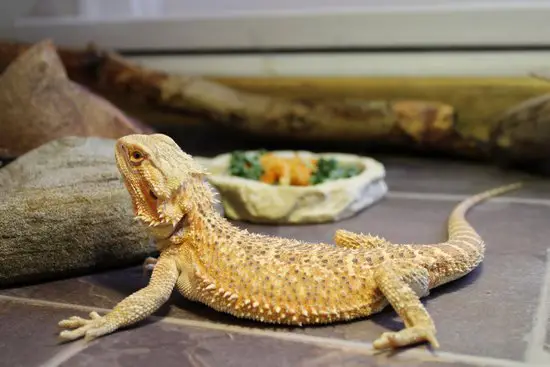
Insect Tweezers
Bearded dragons can mistake your hand for their food if you feed them by hand. Therefore, the best way to feed insects, especially babies, should be by placing them one by one in their tank using insect tweezers.
Last update on 2022-12-30 / Affiliate links / Images from Amazon Product Advertising API
Tips for Bearded Dragon Habitat
Your bearded dragon should be happy, comfortable, and healthy in its tank. Once you are done with their tank set up, it is necessary to maintain the standard and replace anything that is no longer working properly.
Keep The Bearded Dragon’s Tank Clean
Good hygiene in a bearded dragon’s house is very important. Bearded dragon’s poop can be smelly, and food leftovers can grow molds that can cause your bearded dragon fungal infections.
It is, therefore, necessary to remove food leftovers and bearded dragon poop daily. Also, you should thoroughly clean the food and water dish daily with soap and water.
Additionally, it is also critical to wash the entire tank at least once a week, and this should include all the accessories, substrate, and the tank.
Make Adjustment and Change Structure When Needed
If you started with a bearded baby dragon, you probably bought a small tank. And, as the bearded dragon grows, it is necessary to adjust to a larger tank that will properly accommodate it.
Also, it would be best if you changed UVB heat and light bulbs every 6-12 months to maintain the proper heat and light.
These adjustments are inevitable, and failure to adhere can stress your bearded dragon causing it to be susceptible to many diseases and infections.
Final Sentences
Anybody can buy a bearded dragon. But, only those who are willing to study deeply and persist will help their pets thrive in captivity.
Nobody was born knowing. But, we all have an opportunity to learn. We hope this article will help you set up a good habitat for your bearded dragon and keep it healthy and happy.
